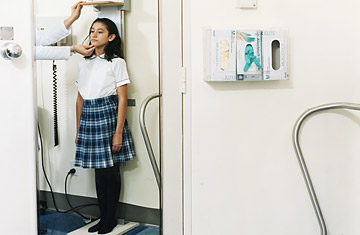
Growth spurts are good — unless they happen too fast and too soon. Then they could suggest premature puberty
(6 of 7)
The chemical industry, unsurprisingly, challenges these findings, and not without reason. The field is still relatively new, the studies are still inconclusive, and there are countless variables that go into determining the precise way environmental chemicals react in any individual body. While there is a broad consensus that many of these chemicals do behave like estrogens, even Patisaul concedes that "there is no smoking gun." However, says Herman-Giddens, if such a cause does exist, the chemical industry is not doing much to help the scientific community find it. "There is resistance to studying these things," she says, "and most of it comes from the industries involved."
Fixing the Problem
Whatever the causes of precocious puberty, the risks are well known. Incidence of breast cancer is higher in women who develop early, owing to the extra years of hormone dosing that sensitive tissues get. Men may face similarly increased danger of testicular or other reproductive-tract cancers. Skeletal problems are much more common. Precocious puberty leads to sudden growth spurts, causing kids to become taller than most of their peers, but that height edge doesn't last. As bone development advances, growth plates may close prematurely, and in the end, those kids wind up shorter--sometimes significantly so--than they would have been otherwise. It is for this reason more than any other that children developing too soon are often prescribed drugs to shut off puberty for a year or two or even longer, allowing their chronological, hormonal and skeletal growths to sync more healthily.
The treatment prescribed for these kids involves monthly injections of a medication that neutralizes the effect of GnRH, not by reducing the level of the hormone in the body but, paradoxically, by increasing it. GnRH is released by the hypothalamus in a pulsing pattern, and the injections are designed to fill in the gaps between the surges. For the first month, this actually causes puberty to accelerate, but the body then begins to interpret the steady-GnRH state as no GnRH at all, and the sped-up maturation stops. The phenomenon is similar to the way an intermittently thrumming window fan will keep you up at night, but when you fill in the gaps in the noise, the smoother whoosh will lull you to sleep. Treatment goes on for as long as it takes a child's calendar age to catch up with developmental age. About six months after the last shot, normal puberty resumes. Monthly injections are not the only way to go. Three-month formulations of the meds are in the pipeline, and subcutaneous implants--similar to long-term contraceptive products--are also available. Implants, however, do not have the same flexibility, since they must be removed and replaced if dosage changes.
While the drugs do work, they can be punishingly expensive--more than $1,400 per month for people without health insurance. Even for insured Americans who can afford the meds, it's still not an easy or happy decision to begin dosing a young child with hormone and growth regulators to control a process that biology and nature had well in hand for millions of years.
